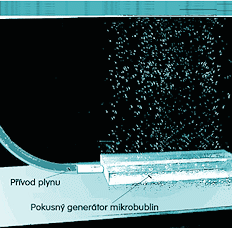The team of scientists from the University of Sheffield, including Prof. Václav Tesař, have received the 2009 Moulton medal for their paper entitled On the design and simulation of an airlift loop bioreactor with microbubble generation by fluidic oscillation published in Food & Bioproducts Processing, 2009. The medal has been awarded anually by The Institution of Chemical Engineers (IchemE) since 1929 for the best scientific paper in the field.
 The team of scientists have received the medal for their contribution towards a solution to one of the essential challenges of the mankind – global warming caused by greenhouse gases, especially CO2.
The team of scientists have received the medal for their contribution towards a solution to one of the essential challenges of the mankind – global warming caused by greenhouse gases, especially CO2.
Prof. W. Zimmerman from the University of Sheffield, UK suggested a method to remove CO2 from the smoke gases. It is based on the generation of microbubbles formed from harmful gases in bioreactors containing active algae. The algae dissociate CO2 into oxygen and carbon, which they require for their own metabolism. The algae can be utilized further as biomass for the production of liquid fuel.
Prof. Tesař's task in the project was to maximize the productivity of the bioreactor. He designed and built the fluidic oscillator, which enables the generation of microbubbles of CO2, which are one order of magnitude smaller that those generated from standard approaches. Due to the large surface available for mass transport of the gas and the slow motion of the extremely small bubbles, he was able to achieve significantly faster growth of algae and higher productivity.
 |
 |
| Large bubbles generated without the fluidic oscillator | Microbubbles generated by the fluidic oscillator |
 |
| Microbubble generator based on the fluidic oscillator |
© 2008–2012 Institute of Thermomechanics ASCR, v. v. i.